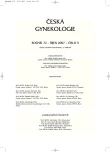Determination Concentrations of Tissue Factor Pathway Inhibitor and their Changes during Estrogen Replacement Therapy
Authors:
Tomáš Fait 1; B. Trnková 3; M. Koštířová 3; M. Vráblík 2
Authors‘ workplace:
Gynekologicko-porodnická klinika VFN Praha a 1. LF UK, Praha, přednosta prof. MUDr. A. Martan, DrSc.
1; III. interní klinika VFN Praha a 1. LF UK, Praha, přednosta prof. MUDr. Š. Svačina, DrSc.
2; Ústav klinické biochemie VFN Praha a l. LF UK, Praha, přednosta prof. MUDr. T. Zima, DrSc.
3
Published in:
Ceska Gynekol 2007; 72(5): 343-347
Category:
Original Article
Overview
Objective:
The purpose of the present study was to determine changes of tissue factor pathway inhibitor (TFPI) as a biochemical risk factors of thromboembolism during the use of different administration methods of the early estrogen replacement therapy.
Design:
Prospective randomized cross-over trial.
Setting:
General Faculty Hospital Prague.
Methods:
In a 12-week prospective, randomized, interventional, cross-over trial, estradiol was administered orally in a dose of 2 mg daily or transdermally in a dose of 0,05 mg daily. Forty-five healthy postmenopausal women were included into the study within 12 weeks after the hysterectomy and ovariectomy (surgical castration). Forty-one women completed the study and their data were analyzed. The average age was of 49 ± 6 years. An enzymatic method (IMUBIND Total TFPI ELISA test) was employed for the determination of TFPI.
Results.
After the oral therapy, the average value of TFPI decreased statistically significantly (p <0.0001) from 87.5 ± 39.1 ng/ml to 68 ± 37.49 ng/ml. Conclusion: Statistically the oral therapy reduced significantly TFPI compared with the transdermal method of administration. In spite of the fact that these changes cannot be unambiguously considered as risky and that the zero change of D-dimers suggests that there was no activation of the coagulation cascade, we consider the neutral effect of the transdermal therapy as more beneficial. The lack of manifestations of the coagulation cascade activation demonstrates the safety of both administration forms of the estrogen replacement therapy in the case of the early administration.
Key words:
estrogen replacement therapy, thromboembolism, TFPI
Labels
Paediatric gynaecology Gynaecology and obstetrics Reproduction medicineArticle was published in
Czech Gynaecology

2007 Issue 5
Most read in this issue
- Inherited Metabolic Disorders and Pregnancy
- Basal-like Carcinoma of the Breast – the Actual Review and Clinico-Pathological Corelations
- Da Vinci Robotic Surgery in Gynaecological Oncology: a Critical Interim Appraisal
- Progression and Regression Low Grade Intraepitelial Squamous Lesions in Context of Positivity of High Risk Human Papillomavirus
